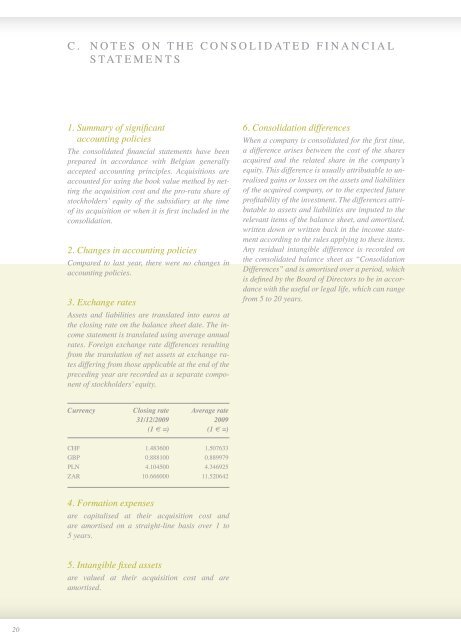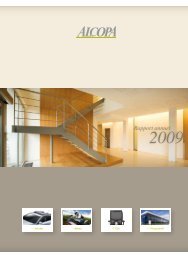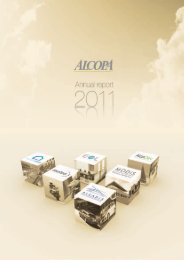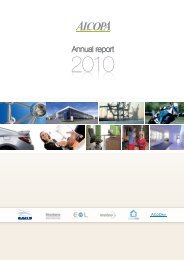Annual report - Alcopa
Annual report - Alcopa
Annual report - Alcopa
Create successful ePaper yourself
Turn your PDF publications into a flip-book with our unique Google optimized e-Paper software.
C. Notes on the Consolidated Financial<br />
Statements<br />
1. Summary of significant<br />
accounting policies<br />
The consolidated financial statements have been<br />
prepared in accordance with Belgian generally<br />
accepted accounting principles. Acquisitions are<br />
accounted for using the book value method by netting<br />
the acquisition cost and the pro-rata share of<br />
stockholders’ equity of the subsidiary at the time<br />
of its acquisition or when it is first included in the<br />
consolidation.<br />
2. Changes in accounting policies<br />
Compared to last year, there were no changes in<br />
accounting policies.<br />
3. Exchange rates<br />
Assets and liabilities are translated into euros at<br />
the closing rate on the balance sheet date. The income<br />
statement is translated using average annual<br />
rates. Foreign exchange rate differences resulting<br />
from the translation of net assets at exchange rates<br />
differing from those applicable at the end of the<br />
preceding year are recorded as a separate component<br />
of stockholders’ equity.<br />
Currency Closing rate Average rate<br />
31/12/2009 2009<br />
(1 € =) (1 € =)<br />
6. Consolidation differences<br />
When a company is consolidated for the first time,<br />
a difference arises between the cost of the shares<br />
acquired and the related share in the company’s<br />
equity. This difference is usually attributable to unrealised<br />
gains or losses on the assets and liabilities<br />
of the acquired company, or to the expected future<br />
profitability of the investment. The differences attributable<br />
to assets and liabilities are imputed to the<br />
relevant items of the balance sheet, and amortised,<br />
written down or written back in the income statement<br />
according to the rules applying to these items.<br />
Any residual intangible difference is recorded on<br />
the consolidated balance sheet as “Consolidation<br />
Differences” and is amortised over a period, which<br />
is defined by the Board of Directors to be in accordance<br />
with the useful or legal life, which can range<br />
from 5 to 20 years.<br />
7. Tangible fixed assets<br />
are capitalised at cost and depreciated over their expected useful life, according to the following<br />
schedule.<br />
Land<br />
Regime Min. Max.<br />
none<br />
Buildings linear 2.5 % 10 %<br />
Furniture and office equipment Linear 10 % 50 %<br />
Installations, machinery linear 10 % 25 %<br />
Rebuilding linear 10 % 20 %<br />
Vehicles linear 20 % 33.33 %<br />
Other tangible fixed assets Linear 33.33 % 100 %<br />
Parking lot linear 20 %<br />
Rented assets linear as of the initial renting month 20 % 33.33 %<br />
Rented cars<br />
linear over the contract term,<br />
less the estimated residual value 20 % 33.33 %<br />
Computer software linear 33.33 % 50 %<br />
Fixed assets under construction<br />
and advance payments linear 0 % 5 %<br />
Leasing and other similar rights Linear over the contract term<br />
The tangible fixed assets are subject to some complementary or extraordinary depreciation when, for<br />
reasons of change or modification in the economical or technological circumstances, their book value<br />
surpasses the company’s useful value.<br />
CHF 1.483600 1.507633<br />
GBP 0.888100 0.889979<br />
PLN 4.104500 4.346925<br />
ZAR 10.666000 11.520642<br />
4. Formation expenses<br />
are capitalised at their acquisition cost and<br />
are amortised on a straight-line basis over 1 to<br />
5 years.<br />
5. Intangible fixed assets<br />
are valued at their acquisition cost and are<br />
amortised.<br />
20 21






